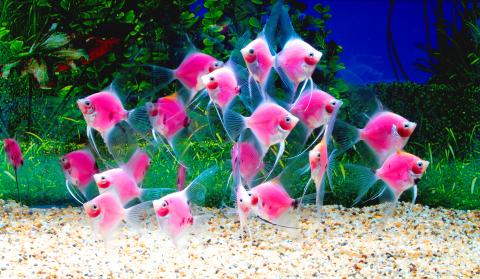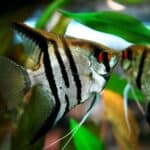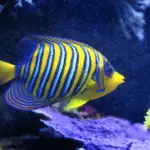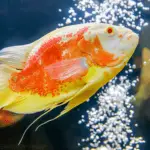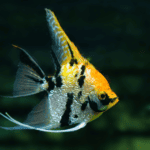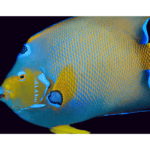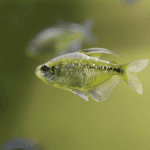Pink angelfish, with their subtle hues and graceful presence, are a favorite among aquarium enthusiasts. These freshwater fish belong to the Cichlidae family and are distinguished by their laterally compressed bodies, elongated triangular fins, and distinctively shimmering pink coloration. Originating from the Amazon Basin, they are a testament to the rich diversity of aquatic life found in tropical South America.
Understanding pink angelfish requires considering aspects such as their specific care requirements and the conditions of their natural habitat to replicate in home aquariums. The correct tank setup is crucial, including parameters like water temperature, pH balance, and plant life that can mimic their environment in the wild. Their diet should be varied and nutritionally balanced to maintain their health and vibrant coloration.
Key Takeaways
- Pink angelfish are popular for their unique color and require specific care.
- They originate from tropical regions and need a tank setup that mimics their natural habitat.
- A varied diet and proper tank conditions are essential for their well-being.
Angelfish Origins and Species
In our research, we focus on angelfish from the genus Pterophyllum, native to the tropical regions of South America. These cichlids are synonymous with their distinct body shapes and graceful presence in freshwater aquaria.
Habitat and Distribution
Angelfish thrive in the slow-moving waterways of the Amazon Basin. Their natural habitat includes rivers, floodplains, and blackwater conditions known for soft and acidic water. Notable among these are the tributaries of the Amazon River. Here’s a look at their distribution:
- Pterophyllum scalare: Widely distributed across the Amazon Basin.
- Pterophyllum altum: Predominantly found in the Orinoco Basin and parts of the Rio Negro.
- Pterophyllum leopoldi: The least common, inhabiting the waters around the Brazilian Amazon, particularly in the regions close to the border with Peru.
Identifying Species
Each species under the genus Pterophyllum can be identified by observing specific physical characteristics:
- P. scalare: Recognized for its tall, laterally compressed body and notched dorsal and anal fins.
- Size: Up to 6 inches (15 cm) in height.
- Body Shape: Angled between the dorsal and anal fins.
- P. altum: Distinguished by a notably taller body and straighter head profile.
- Size: Can grow notably taller than P. scalare, reaching up to 7 to 9 inches (18-23 cm).
- Divergence: It is the deepest-bodied species, making it stand out in appearance.
- P. leopoldi: The smallest and most streamlined species with a concave head profile.
- Size: Typically smaller, with a maximum height of around 5 inches (13 cm).
- Identifying Mark: One or two black vertical stripes with a unique ‘half-moon’ shaped notch in the nose.
Our exploration into the origins and species of angelfish reveals a complex natural history tied to the biodiverse ecosystems of South America’s freshwater environments. Through understanding their habitat and distinctive physical traits, we gain a clearer image of these graceful inhabitants of the Amazonian aquatic world.
Physical Characteristics and Varieties
We will explore the distinctive aspects of the pink angelfish, focusing on its color patterns and overall size, along with identifying its distinct features that differentiate various varieties.
Color Patterns and Size
The pink angelfish typically ranges in size from 6 to 10 inches in length, showcasing a diverse palette of color variations. Notable among these are the silver base with potential shades of black, gold, or blue. Additionally, varieties such as the marble, koi, albino, and blushing types offer a unique mix of these colors, often combined with patches, stripes, or a more uniform hue. The zebra type is particularly known for its black stripes against a contrasting background. Fish with a preponderance of orange, yellow, white, or blue scales also exist, providing aquarists a broad range to choose from.
- Marble: Irregular patterns of black and white
- Koi: Resembling koi fish, with orange and white coloration
- Albino: Lacking pigmentation, presenting a pale white or pink appearance
- Blushing: White fish with visible gills due to lack of pigmentation, giving a ‘blushing’ appearance
- Blue: Ranging from light to deep blue hues
- Zebra: Vertical black stripes on a silver or white body
Sizes of the pink angelfish can be influenced by factors such as tank conditions, diet, and lineage.
Distinct Features
Each variety of pink angelfish brings its own distinct features beyond color. The scales of these angelfish are typically large and smooth, giving them an almost shimmering appearance. Some varieties, like the marble, have a mottled pattern that is often random and can change over the course of the fish’s life. Distinct physical characteristics such as finnage can also be observed, with some angelfish varieties developing long, flowing fins, while others may have shorter, more compact fins due to selective breeding.
It is worth noting that the health of these features, particularly the fins, can be impacted by conditions such as fin rot, which is recognizable by frayed or disintegrating fins. Proper care and early detection are crucial to maintain the distinctive appearance and health of pink angelfish.
Angelfish Care and Tank Setup
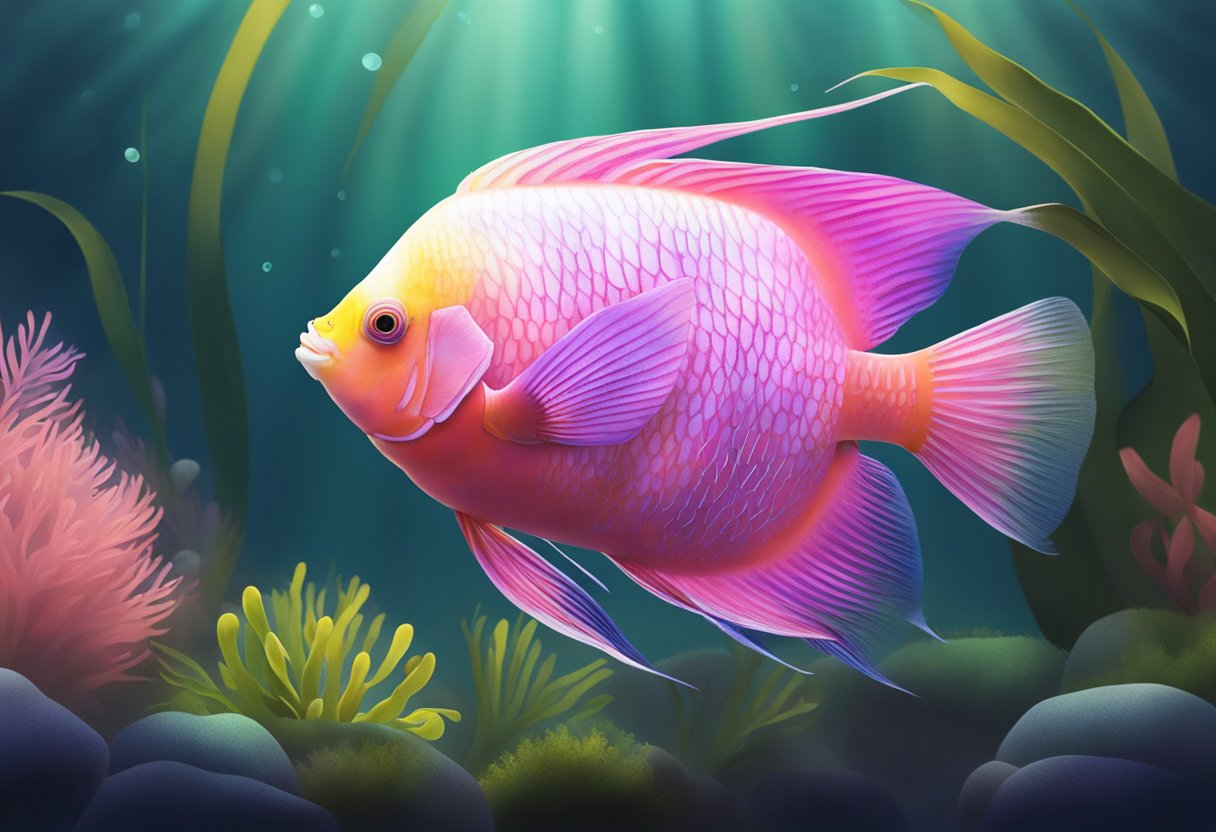
In caring for pink angelfish, ensuring the correct tank conditions and creating a conducive habitat are crucial. We aim to provide a stable environment that closely mimics their natural habitat.
Tank Conditions
Tank size: For pink angelfish, a minimum tank size of 30 gallons is advisable for a pair; however, if we intend to keep a group or add other fish, a larger tank is necessary.
Temperature and Water Conditions:
- Temperature: Maintain a water temperature between 76°F and 82°F (24°C to 28°C).
- pH levels: Aim for a pH level ranging from 6.0 to 7.5, which allows for slightly acidic to neutral conditions.
- Water hardness: Keep soft to moderate water hardness, between 5 and 13 dKH.
To ensure optimal water quality, a robust filtration system is a must. It keeps the water clean and well-oxygenated, a key aspect in ensuring the health and vitality of the angelfish. Regular water changes, about 20% weekly, are recommended to maintain water quality.
Creating a Conducive Habitat
Substrate: We choose a substrate that doesn’t only serve an aesthetic purpose but also one that the fish can sift through comfortably. Fine-grade sand or smooth gravel makes an excellent choice for the bottom layer.
Plants and Decorations:
- Live plants: Incorporate a variety of live plants such as amazon sword and java fern, which serve as hiding spots and contribute to the tank’s ecological balance.
- Decorations: Add rocks or driftwood to provide additional hiding spaces and to replicate the natural structures found in their habitat.
We carefully arrange the plants and decorations to allow ample space for swimming and to establish territories, particularly if housing more than one angelfish. Remember, complex environments contribute to the wellbeing of our angelfish by providing stimulation and maintaining a healthier ecosystem within the tank.
Feeding and Diet
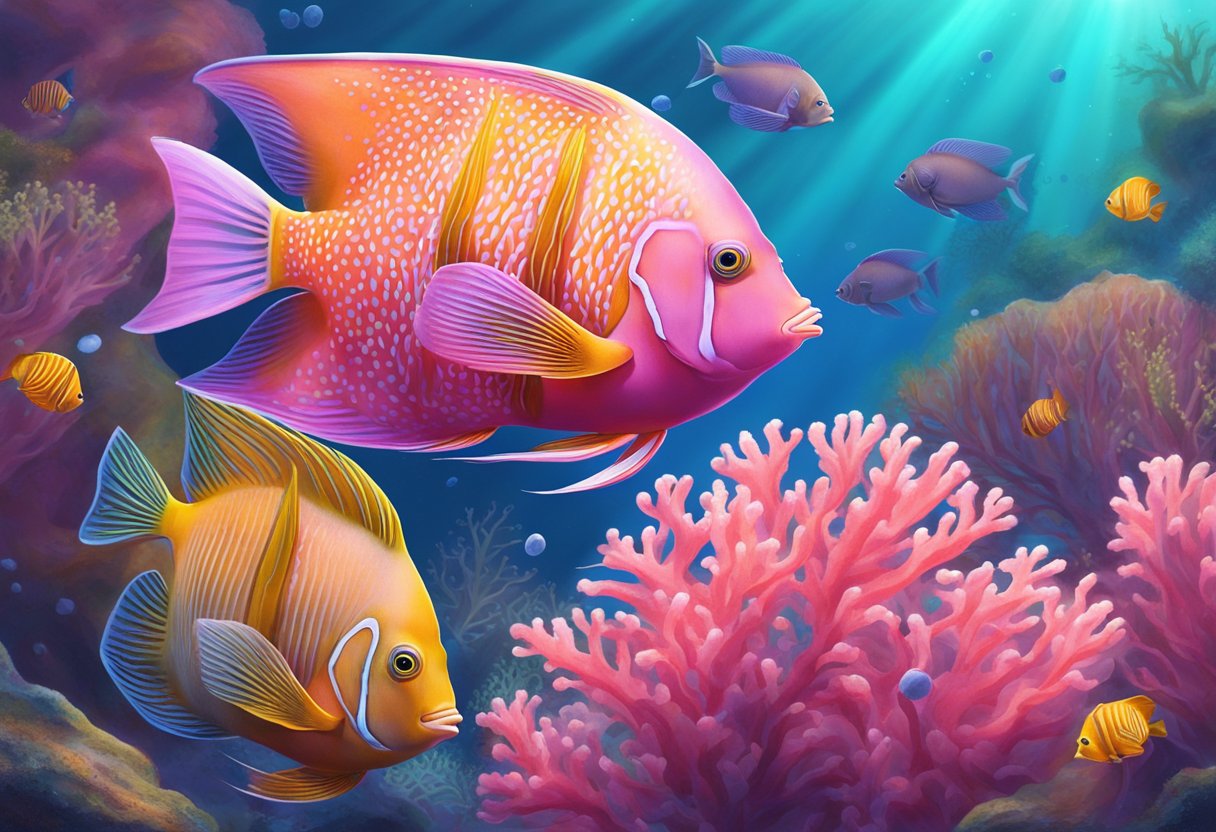
In caring for pink angelfish, understanding their diet and feeding practices is crucial for their health and growth. These fish are omnivores, requiring a mix of nutrients that can be provided through various types of food, both live and prepared.
Types of Food
Pink angelfish thrive on a varied diet that includes both live and prepared foods. Their dietary needs can be met with:
- Live foods: To promote vibrant health, we give them live foods like brine shrimp and bloodworms.
- Prepared foods: High-quality flakes and pellets designed for angelfish provide balanced nutrition that is essential for their well-being.
Feeding Practices
When we feed pink angelfish, we follow these practices to ensure they receive adequate nutrition:
- Frequency: We feed adult angelfish twice a day and fry (juvenile angelfish) more frequently to support their rapid growth.
- Quantity: The amount of food given is carefully measured so each angelfish can consume it within a few minutes. This prevents overfeeding and maintains water quality.
By adhering to these feeding principles, we can maintain the health and vitality of pink angelfish.
Breeding and Lifecycle
In our experience with pink angelfish, their breeding and lifecycle are characterized by unique behaviors and developmental stages. The meticulous care for angelfish fry is crucial to ensure their survival and health throughout their lifespan.
Breeding Behavior
We have observed that pink angelfish usually reach sexual maturity at around 6-12 months of age, although this can vary. During the breeding season, which occurs throughout the year in stable aquarium conditions, a male and female pair will prepare for spawning. The pair will clean a flat surface where the female will lay her eggs. Spawning events involve sticking eggs to the chosen surface, which can be plant leaves, aquarium glass, or specially provided spawning slates. We note that a healthy female can lay hundreds of eggs in a single spawning.
- Initiation: Pre-spawning behavior includes cleaning the surface.
- Spawning: Laying of eggs, typically in neat rows.
- Post-spawning: Both parents often guard the eggs, fanning them for oxygenation and protecting them from potential threats.
Raising Angelfish Fry
After the eggs hatch, which takes about 60 hours at 27°C (80°F), the angelfish fry, which are initially immobile and feed off their yolk sac, require diligent care. Once they become free-swimming, we begin feeding them specialized foods. We recommend a diet rich in nutrients for optimal growth. Brine shrimp nauplii or commercial fry food are excellent choices during the early life stages.
- Hatchlings: Angelfish eggs hatch into wrigglers and live off their yolk sac.
- Free-swimming Fry: After 5-7 days, they start swimming and seeking food.
- Care Level: Water quality and temperature must be carefully maintained, and frequent feedings are crucial.
Proper breeding and raising practices ensure the health and longevity of pink angelfish which can live up to 10 years with appropriate care.
Health and Common Issues
Proper health management is vital for maintaining thriving pink angelfish. We must pay attention to disease prevention, and understand the role stress and aggression play in their well-being.
Disease Prevention
Quality of Water: Consistently maintaining high-quality water conditions is crucial in disease prevention. We need to test water parameters regularly, aiming for:
- pH: 6.5 – 7.5
- Temperature: 76-82°F (24-28°C)
- Ammonia/Nitrite: 0 ppm
- Nitrate: <40 ppm
Regular water changes, typically 25-30% bi-weekly, help prevent the accumulation of harmful toxins.
Common Diseases:
Ich (White Spot Disease): Observe for white spots resembling salt grains on the skin, fins, and gills. Ich is contagious and responds to increased water temperature and medicinal treatment.
Fin Rot: This bacterial infection often stems from poor water quality and exhibits as frayed or decaying fins. Consistent water maintenance and antibiotics can manage fin rot.
Stress and Aggression
Temperament: Pink angelfish vary in temperament from semi-aggressive to peaceful but can become territorial if confined or crowded. To manage stress and aggression, provide:
- Adequate space: A larger tank to ensure sufficient territory.
- Environmental enrichment: Plants, rocks, and hiding places.
Inter-species Dynamics: Manage stocking density and species compatibility. Aggression can be mitigated by housing pink angelfish with compatible, similarly-tempered fish, and avoiding overly aggressive or fin-nipping species.
Frequently Asked Questions
In this section, we address some of the most common inquiries regarding Pink Angelfish, with focused answers tailored to both prospective buyers and seasoned aquarists.
What are the care requirements for Pink Angelfish in freshwater aquaria?
To maintain Pink Angelfish, we need a well-oxygenated tank with a capacity of at least 20 gallons and a stable temperature between 76 and 86 degrees Fahrenheit. A pH level of 6.8 to 7.8 is optimal, and weekly water changes of 10-25% are recommended to keep these angelfish in a healthy environment.
What tank mates are suitable for Pink Angelfish?
Suitable tank mates for Pink Angelfish are peaceful fish that thrive in similar water conditions. We should avoid fin-nippers like some barbs and overly aggressive species. Good companions include small Tetras, Corydoras, and Dwarf Gouramis, which tend to coexist well with angelfish.
What distinguishes Marble, Blue, and Platinum Angelfish from Pink Angelfish?
Marble Angelfish have a mix of dark and light patches over their bodies. Blue Angelfish exhibit a bluish hue due to a specific gene, while Platinum Angelfish are primarily silvery-white. Pink Angelfish set themselves apart with their unique pinkish tones, which come from a lack of darker pigmentation.
How much does a typical Pink Angelfish cost?
The price for a Pink Angelfish usually varies from $10 to $20, depending on the size and quality. Prices can be higher for specimen with particularly vibrant coloration or for rare strains.
What are the maximum size and growth characteristics of Pink Angelfish?
Pink Angelfish can grow up to 6 inches in height and about 8 inches in length, including their fins. Our experience suggests they typically reach full size within a year, provided they’re kept in optimal conditions and fed a high-quality diet.
Some rare varieties related to Pink Angelfish include the Leopoldi Angelfish, characterized by a more pointed snout and smaller size, and the Altum Angelfish, which can be distinguished by its notably larger size and unique striped pattern. Both are less common and can be a challenge to find in the aquarium trade.
